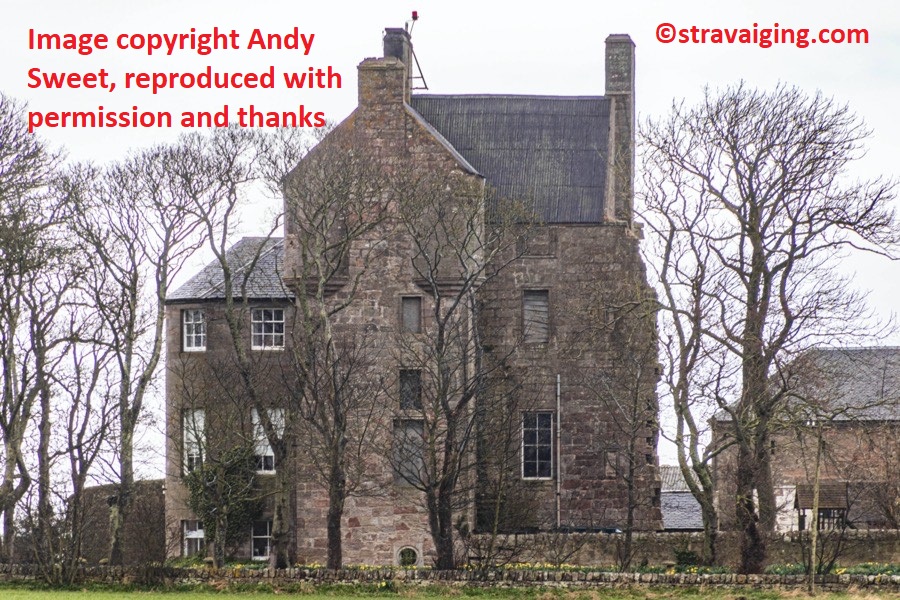Balcomie Castle

Balcomie Castle Details
Balcomie Castle, unoccupied but private C16 tower house of the Learmouths extended C17 with modern house adjacent
- Closest To: Crail, Anstruther
- Access: Occasional Access
- Grid Reference: NO625099
Balcomie Castle is a tower house dated to the 16th century adjacent to which is a house that was added in the 18th century. The tower is wind and watertight, but is unoccupied, and part of the recently renovated house is available for holiday lets. Balcomie is situated on rising ground close to Fife Ness, and is part of a working farm.
The lands of Balcomie were held by the Hay family in the latter 13th century, and this family may have continued to hold the lands, taking the designation de Balcomie, into the early 15th century. In 1455 George Lauder, Bishop of Orkney, was also lord of Balcomie, but in 1465 it was granted to Alexander Leslie of Wardis and his spouse Isabella de Lauder, the heiress. (It is possible that the Lauders also axcquired Balcomie by marriage – Isabella was daughter to the laird of The Bass and his wife Janet, and Janet was the daughter of Alexander Hume and a Janet Hay. ) Alexander Leslie was succeeded by his younger son Walter in 1499 when Isabella resigned it to him, but the following year Walter resigned Balcomie to his elder brother John, who is believed to have died at Flodden, at which point Balcomie escheated to the Crown.
In 1526 Sir James Learmonth acquired the lands, and the Learmonth family stayed at Balcomie until the death of Robert Learmonth in 1696, who left the estate encumbered with debt. The castle was therefore erected by them – and it is likely that when Mary of Guise landed here in 1535, there was a tower house of some description at Balcomie. Sir James Learmonth was Master of the Kings Household, treasurer, and provost of St Andrews for many years. He was also Master of the Horse for King James V, and was killed at Pinkie in 1547. He was followed by his son Patrick, but in 1551 George was infeft as heir of his father James, indicating Patrick had died. George’s son James succeeded him in 1585, and died without children in Orkney as a prisoner of Islesmen who had resented lowland colonisation from Fife. He was therefore succeeded by his brother John in 1600, and John by James in 1620. James was a judge, but ended up deprived of all his offices in 1649. Restored to the judiciary in 1655, he died at his bench two years later. His eldest son having been killed opposing Cromwell in 1651, he was succeeded by his second son Robert, last of the Learmonths. In 1705 the estate was purchased by Sir William Hope of Kirkliston, although he had difficulty evicting Robert’s son in law William Gordon, who had received a charter to it but not resolved the debt issue. The Hopes remained until 1766, when the widow of the last laird sold Balcomie to General Scot of Scotstarvit, who was responsible for the building of the house. Upon his death the estate was sold to the Earl of Kellie, who pulled down a substantial part of the old house – and it has since been sold again many times.
The descriptions of the castle are, to be honest, confusing. However what is clear is that there was a substantial L-plan building of some complexity, with a walled courtyard; the arched entrance to this courtyard survives with some very high quality heraldic architecture from the 17th century. The tower as it survives consists of two squarish towers, the larger to the north-east of the smaller; a corbelled out turret stair connects the first and second floors in the southern re-entrant. The smaller tower contained five floors (the basement vaulted) and an attic, with round turrets on the southern corners. The larger block contained four floors and an attic. The east-facing wall today was an internal wall when the castle was in use, with a large fireplace on the first floor, and a wall scar shows that it extended further to the east. The later house extends to the north, and is attached to the larger tower with a connecting building, as it is offset to the west slightly. It is presumably the case that the farm buildings and mansion were added in the early 19th century at the same time that the old house was partly demolished, so it is fortunate that as much survives as it has.
The photograph is from Andy Sweet’s website (with his permission!) and is his copyright. His entry on Balcomie can be seen here.
HES Canmore database entry
Balcomie Castle Farmhouse website
